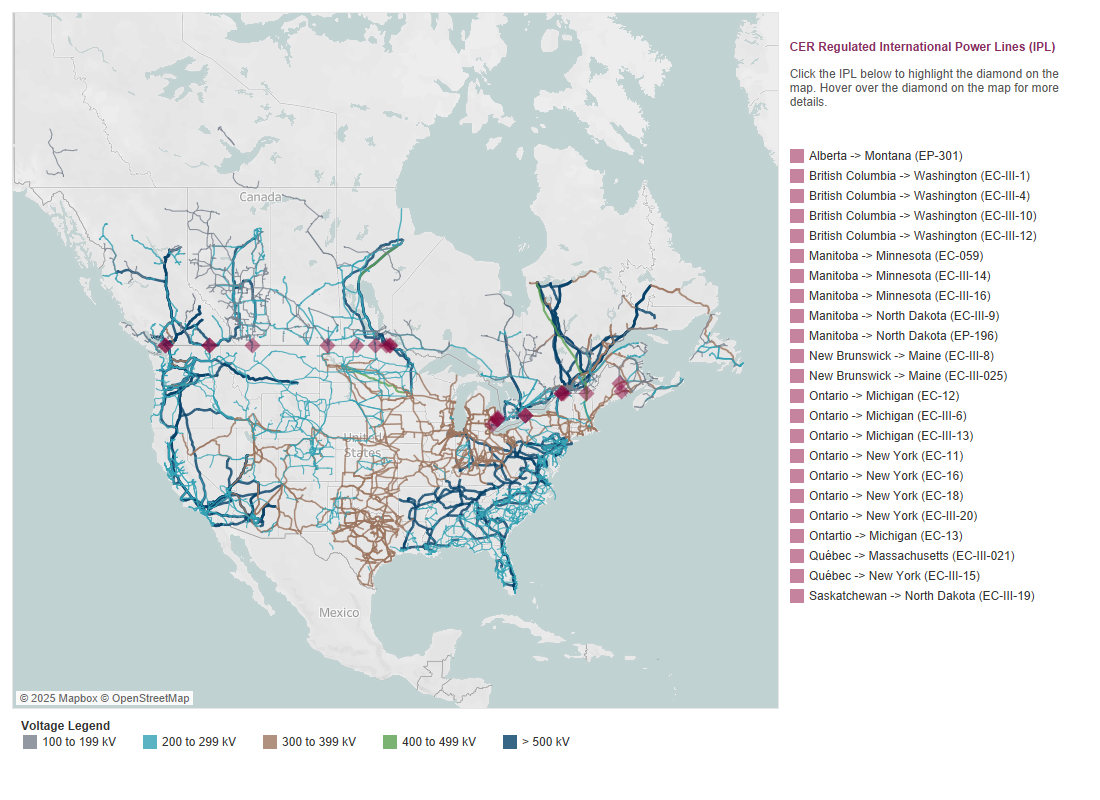Canada’s electricity trade plays a crucial role in the North American energy landscape, with strong cross-border ties to the United States and varying degrees of interprovincial connectivity. Governed by both federal and provincial authorities, electricity trade occurs through a network of international power lines and domestic transmission systems, balancing supply, demand, and economic considerations.
Back in 2023, we wrote about the possibility of a pan-Canadian electricity grid after the federal government launched an Electricity Advisory Council to provide recommendations on its viability. At the time, it was through the lens of finding efficiencies and helping the country meet its net-zero emissions goals.
In recent months, the significance of interprovincial electricity connectivity has grown, particularly in the face of shifting U.S. trade policies under the Trump administration and the threat of tariffs. With the potential for trade disputes affecting electricity exports to the U.S., there is renewed interest from provinces and Canadians to prioritize strengthening our domestic energy connections to ensure energy security, price stability, and economic resilience for the future.

The role of the Canada Energy Regulator (CER)
First, let’s talk about our cross-border trade. The Canada Energy Regulator (CER) oversees electricity exports to the U.S., ensuring compliance with market regulations, fair access, and impact assessments on domestic supply. It should be noted that the CER does not regulate electricity imports into Canada. That’s the role of provincial Crown corporations or private market participants, who decide on the volume of electricity being traded.
In terms of infrastructure, the CER regulates 86 international power lines that connect Canada’s provinces to the U.S. electricity grid. These transmission lines vary in length, with many spanning only a few kilometres from substations to various connection points along the international border. For example, B.C. is linked to the Pacific Northwest grid; Manitoba is linked to the U.S. midcontinent grid; Ontario to both the U.S. midcontinent and eastern grids; Quebec to the U.S. eastern grid; and New Brunswick to the U.S. New England grid.

Interprovincial vs. U.S. trade
In Canada, we do not have a national grid. In fact, Canada's electricity infrastructure consists of multiple grids, each governed and regulated by its respective province or territory (not the federal government). They also vary in systems and resources for producing electricity, with some regions having ample access to water resources, while others rely heavily on nuclear energy or oil and gas.
In short, Canada’s electricity grids were designed to serve local demand rather than support a large-scale integrated and interprovincial grid for all. This is the main reason why the majority of Canada’s electricity grids are oriented north-south, rather than east-west, reinforcing a stronger trade relationship to meet the higher demand from the U.S. rather than between provinces.
“An integrated approach to our electricity systems would allow provinces to take advantage of different technology and resources from other regions, reduce costs, and meet their climate targets in a way that is affordable, resilient, reliable and clean,” says Moe Kabarra, Vice President of the Transition Accelerator, a non-profit organization dedicated to accelerating the transition to a low-carbon economy.

Currently, however, the lack of extensive infrastructure to support east-west interconnections (not to mention provincial regulatory barriers) means that provinces with electricity shortages or surpluses often turn to U.S. markets rather than neighbouring Canadian provinces for solutions. But there has been some movement: In August 2023, the governments of Ontario and Quebec announced a 600 MW electricity trade agreement, whereby Ontario will provide 600 MW of electricity to Quebec in the winter, and Quebec will provide 600 MW to Ontario in the summer.
That being said, it is important to note that all provinces, with the exception of PEI (who imports all their off-island electricity using subsea transmission cables from New Brunswick), trade electricity with their neighbouring provinces. For example, according to CER: “Ontario has interconnections with Manitoba, Quebec, Michigan, Minnesota, and New York. Most of Ontario’s imports come from Quebec while most of Ontario’s exports go to New York and Michigan.”
At this point, you might be asking “What about the territories?” According to the CER market snapshot page, it is important to note that electricity transmission lines in the Yukon and Northwest Territories do not connect to the larger North American grids or even to each other. And Nunavut doesn’t have any transmission lines connecting its communities at all; but rather each community independently generates and distributes its own electricity.
Author’s note: For context on some reasons why these domestic north-south connections weren’t prioritized previously, check out our blog Electrifying Canada’s rural and remote communities for some more insight.
Looking ahead
As Canada navigates global trade uncertainties, reinforcing interprovincial connectivity could be critical to securing a stable and sustainable electricity network. While cross-border trade remains a key pillar of Canada’s energy economy ($3.2-billion worth of power was sold to the U.S. in 2023), the reality of shifting trade policies and recent events have highlighted the importance of strengthening our domestic connections.
The challenge will be to outline recommendations to create a true pan-Canadian electricity grid, including identifying the infrastructure needed, the regulatory and policy changes required, and the necessary investments to make it happen.
By advancing interprovincial infrastructure and collaboration, Canada can build a more resilient energy system - one that not only supports economic efficiency and net-zero goals but also ensures long-term energy security, price stability, and (perhaps most importantly) adaptability in an evolving global landscape.